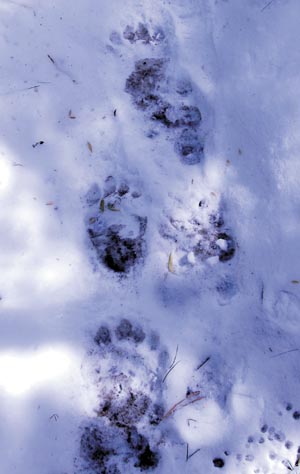Getting Out: When I give a backpacking class or talk to people
about solo-backpacking trips I have taken in the Sierra, I am
always surprised by concerns they express about the dangers that
lurk there.
When I give a backpacking class or talk to people about solo-backpacking trips I have taken in the Sierra, I am always surprised by concerns they express about the dangers that lurk there.
“What about bears?”
“Do you carry a gun?”
“What if something happens?”
My standard response is that 95 percent of the danger of a backpacking trip is the drive to the trailhead and back again. I made up the statistics, but the truth is surely that lopsided. Traveling in the wilderness is far less dangerous that driving our highways, but driving is part of our daily routine that we accept and understand. In the middle of nowhere, where things go bump in the night, everything is very strange to us. We are vulnerable and without our usual handy safety valves – no lights, no phones, no locked doors.
While the fear people feel is wildly out of proportion with any actual danger, it is understandable and natural. Deep in our cellular memory, we recall racing across some long lost savannah, a hungry predator on our heels. But for the most part, we have tamed the world, and any danger is largely imagined.
Or is it? Earlier this month, two hikers in Yellowstone National Park surprised a grizzly sow and her two cubs. One person was killed as the bear sought to protect her young. Incidents like this stir our primal fear and enlarge the scope of the danger in our minds. But seen in the proper context, it is clear the likelihood of such an attack is small. This is the first such fatality in Yellowstone, a park that gets 3.5 million visitors a year, since 1986.
While the grizzly bear adorns our state flag, we exterminated it in California a century ago. If a bear visits your campsite in the Sierra, it is a black bear whose only interest is your food. If you have properly hung it in a tree, or better yet, secured it in a bear-proof container, you have nothing to fear.
Years ago at Grant Lakes in Yosemite, near bedtime, we heard some backpackers across the lake yelling and banging pots. We knew they had an intruder and that our campsite would likely be on the bear’s evening route, but I was confident that I had properly hung my food out of harm’s way. In the night, I awoke to a succession of sounds repeated several times over: Claws scratching up the nearby tree trunk followed by a thud and exasperated exhale after each failed attempt to get my food. When those sounds finally ended, yet he was still there, I knew he was dining at my expense.
Even though I was safe, and I knew the bear meant no harm that night, my imagination took off. The animal is big, wild, and it’s out there with only a layer of nylon and goose down between us.
But this is the great gift of backcountry travel; we are visitors in a strange place without our security blanket, and we must rely on simple resourcefulness. Are we crafty enough to deal with an unexpected problem with just the tools on our backs?
The cars and the criminals – the real dangers – are not in the wilderness. If you are prudent, the wilderness is simply unfamiliar and spooky. Go there with care, be wary, spooked a little, and surrender to the fact that you are not it complete control. When you return, you’ll be a little different.










